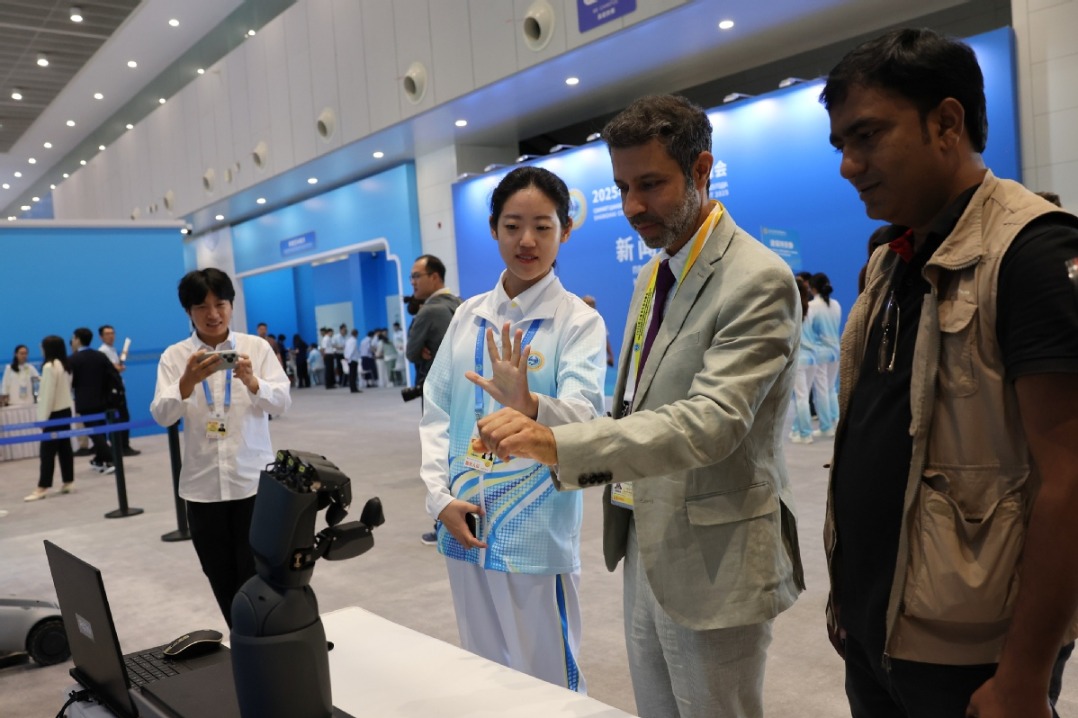Brain-machine interface device helps ALS patient communicate her feelings

A patient with speech loss due to amyotrophic lateral sclerosis (ALS) has regained her ability to communicate her feelings, thanks to a recent implantation of a brain-machine interface (BMI) device.
Three hospitals in Beijing announced on Thursday that they have completed the world's first human implantations of BMI devices, called the "NeuCyber Matrix BMI System", which enables paralyzed patients to drink water by controlling a robotic arm with their mind and enables an aphasic patient to communicate.
The system is a semi-invasive, wireless BMI implant independently developed by China. It features a flexible, high-density electrode applied on the cortex that record, process and transmit brain signals with a high sampling rate, high throughput, and low power consumption.
"The device collects signals from 128 channels, or 128 different locations in the brain simultaneously, having the highest throughput among its peers," said Luo Minmin, director of the Chinese Institute for Brain Research in Beijing.
Zhao Guoguang, director of the National Center for Neurological Disorders and president of Xuanwu Hospital of Capital Medical University, said that his team had performed the first implantation surgery of a Chinese language wireless BMI implant on a patient with ALS-induced speech loss this month.
The NeuCyber Matrix BMI System was successfully implanted in the key area of the patient's left brain that controls speech, he said during an interview on Thursday.
The 67-year-old patient has suffered from ALS since 2023, and as the disease progressed, she developed severe articulation disorders, seriously hindering her verbal communication with the outside world.
The surgery, which was assisted by a neurosurgical robot, had placed a thin, flexible electrode with 128 channels on the dura mater, which is the outermost layer of the three membranes that surround and protect the brain and spinal cord. The aim is to achieve high-quality neural signal acquisition with minimal trauma.
Then, a coin-sized device responsible for control and signal transmission was embedded on the skull surface, which enables efficient transmission of neural signals through near-field communication and supplies power, Zhao said.
The BMI device is trained to recognize the brain patterns produced when certain words were spoken internally, or thought, usually accomplished by flashing a word on a screen and asking the participant to "say" the word internally. Then, the BMI algorithms were able to predict the words tested, according to a 2024 study published on Nature Human Behaviour.
On March 10, five days after the surgery, the patient began language decoding training. Of the 128 signal channels, 126 function well, and after just three hours of training, the real-time decoding accuracy for 62 commonly used words reached 34 percent. Now, the accuracy has reached 52 percent, Zhao added.
"With more training, we hope that ALS patients will not only be able to communicate daily necessary needs, but also create poetry, expressing their sentiments and feelings in the future," Zhao said.
In the other clinical trials, after the NeuCyber Matrix BMI System were implanted in two paralyzed patients, they were able to control computers and robotic arms with their thoughts and even control electrical muscle stimulation devices to recover their limb motor functions.
In January, the Beijing Municipal Science and Technology Commission issued an action plan for accelerating the innovative development of brain-machine interfaces in Beijing from 2025 to 2030, which proposes that by 2027, Beijing will make major breakthroughs in core technologies such as brain-machine interface electrodes, chips, and encoding and decoding algorithms.
By 2030, the brain-machine interface industry in Beijing will have taken shape, it says.
Chinese Institute for Brain Research in Beijing and NeuCyber NeuroTech Co Ltd have jointly developed the semi-invasive NeuCyber Matrix BMI System and the invasive NeuCyber Array BMI System, both reaching the world's state-of-the-art levels, the Beijing Municipal Science and Technology Commission said.
Last year, the NeuCyber Array BMI System, a wired version with 1024 channels, was first demonstrated at the opening ceremony of the 2024 Zhongguancun Forum, where a monkey implanted with it controlled a robotic arm with only its thoughts.
- Shaanxi's agricultural zone bears fruit in nurturing talent
- Nation drives green growth, promotes stronger bonds
- SCO commission boosts ties, delivers benefits across region
- Belgian cyclist completes epic journey to Shanghai
- China issues alert on overseas study in Philippines
- Liaoning Port Group launches 'durian express' shipping service





































